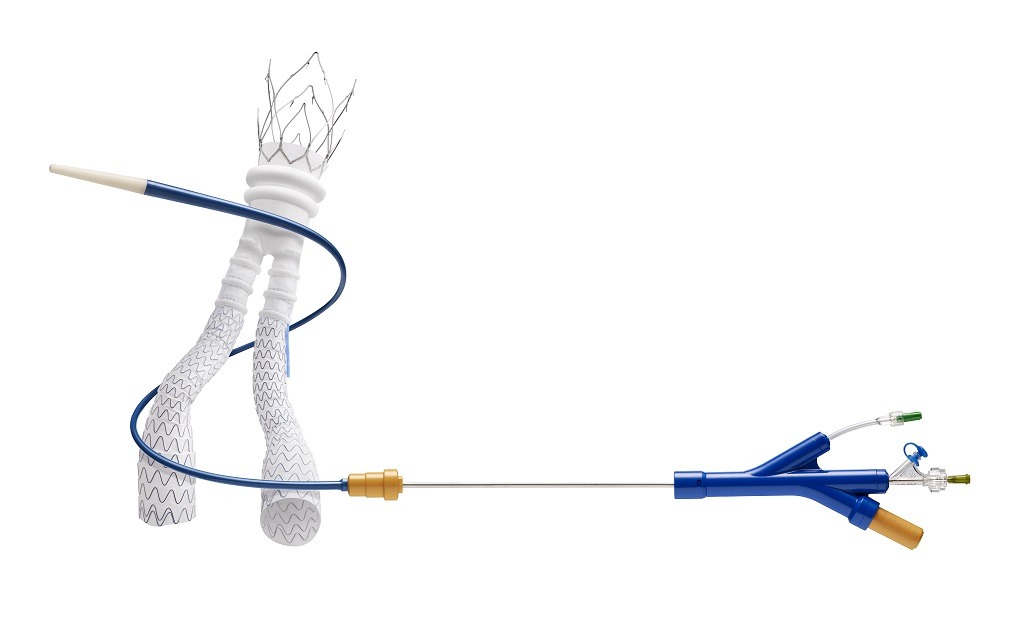
The LIFE registry demonstrated safe and effective patient outcomes when using a “Fast-Track” endovascular aortic repair (EVAR) protocol—percutaneous access, no general anaesthesia, no intensive care unit admission and next-day discharge—according to data presented at the Vascular Interventional Advances (VIVA) annual conference 2016 (18–22 September, Las Vegas, USA).
Presenting the data in a late-breaking trial session, Zvonimir Krajcer, Texas Heart Institute, Houston, USA, reported no device-related or procedure-related major adverse events and 100% freedom from rupture, conversion or secondary interventions. Furthermore, Krajcer said, the Fast-Track protocol “offers significant perioperative cost savings compared to standard EVAR,” largely driven by shorter hospital and intensive care unit stay and a low 30-day hospital readmission rate.
Krajcer and colleagues used the Ovation abdominal stent graft platform (Endologix) under “the least invasive conditions” as defined in their Fast-Track protocol. The registry is a prospective, non-randomised, post-market study involving 250 patients at up to 40 US centres, with a primary endpoint of major adverse event rate within 30 days. The target performance goal was a rate of 10.4%.
At baseline, the majority (71.2%, n=178) of patients were ASA grade III with serious comorbid conditions, 22.8% (n=57) were grade II and 6% (n=15) were grade I. Of the 250 patients enrolled, Fast-Track treatment was completed in 216 (87%). The reason for the failures of Fast-Track treatment were 20 patients remaining in hospital longer than one midnight stay, 11 patients admitted to the intensive care unit, eight patients requiring cut down due to access site failure and six requiring general anaesthesia.
Krajcer reported that procedure time in Fast-Track group was shorter than in the control group, with a mean of 84.2±27.8 mins compared with 99.5±33.9 mins, respectively. Fluoroscopy time was also shorter, at 18.6±8.5 mins for Fast-Track compared with 20.8±7.3 mins for control.
Post-operative recovery was significantly faster for the Fast-Track group compared with the control group. For the Fast-Track group, the median hour to ambulation time was 7.9 compared with 15.8 in the control group and median hour to normal diet time was 5.9 compared with 18.3 in the control group. None of the 216 Fast-Track patients were admitted to the intensive care unit, while 17 (65%) patients in the control group were. The mean hospital stay for the Fast-Track patients was 1.2±0.4 days compared with 2.9±3.2 in the control group.
Furthermore, quality of life improvement in those patients who completed Fast-Track treatment was “highly significant,” Krajcer said, increasing by more than 0.1 on the EQ-5D scale, compared with less than 0.05 for those who did not complete Fast-Track treatment (p<0.001).
There were no device-related or procedure-related major adverse events at 30 days, and one unrelated major adverse event (0.4%; one death at 28 days due to acute respiratory failure)—“the lowest ever recorded for any clinical EVAR trial,” Krajcer noted, and far below the performance goal of 10.4%. Thirty-day rates of freedom from aneurysm rupture, conversion to open repair and aneurysm-related reintervention were 100% in both groups. Thirty-day freedom from mortality was 100% in the control group and 99.5% (n=215/216) in the Fast-Track group. There was one case (0.5%) of type I endoleak in the Fast-Track group between one and 40 days, none in the control group, and no type III endoleaks in either group.
The investigators used a control group of 8,306 undergoing infrarenal EVAR without rupture between 2012 and 2015 at 3,750 US hospitals to analyse cost-effectiveness of a Fast-Track protocol compared with standard EVAR. They looked at costs associated with access, anaesthesia, intensive care unit and hospital stay, and found Fast-Track treatment to be more cost-effective than standard EVAR by an average of US$21,000 (average total US$8,200 for Fast-Track vs. US$29,300 for standard EVAR). The main saving was found in intensive care unit stay—a stay of 1.4 days in the standard EVAR group cost US$15,300, while no Fast-Track patients required a stay.
Thirty-day hospital readmission further underscored the cost-effectiveness of the Fast-Track protocol, with a “readmission rate five times less than contemporary EVAR reports,” Krajcer said, at 1.6%. He explained that the most common causes for readmission were myocardial infarction and renal, respiratory or wound complications. Previously published studies have identified a median EVAR readmission cost of US$17,700 for graft occlusion and US$23,600 for endoleak. These costs are mostly driven, Krajcer explained, by additional surgeries, intensive care unit services and hospital length of stay, much of which can be avoided with the use of the Fast-Track protocol.
“The LIFE registry is the first ever prospective study to demonstrate safe and effective patient outcomes when utilising a Fast-Track EVAR protocol,” Krajcer told the audience. Based on these promising clinical and cost-effectiveness outcomes, he suggested that the results now warrant establishment of Fast-Track protocols at experienced EVAR centres.













